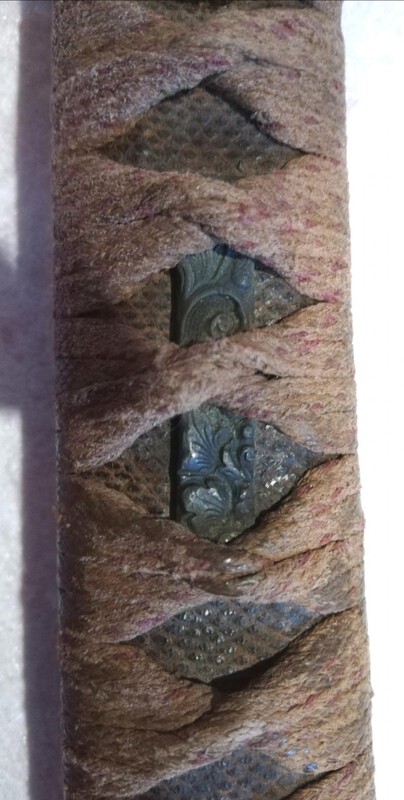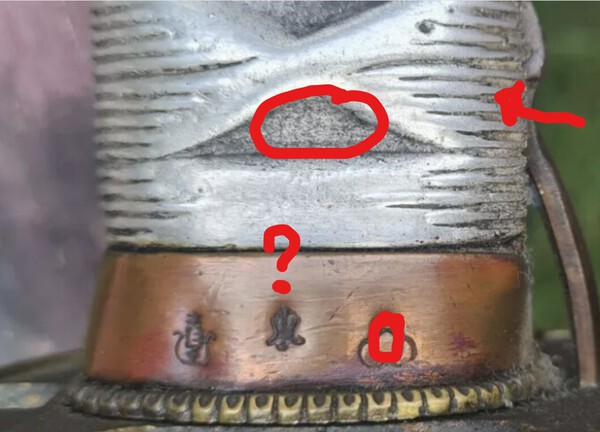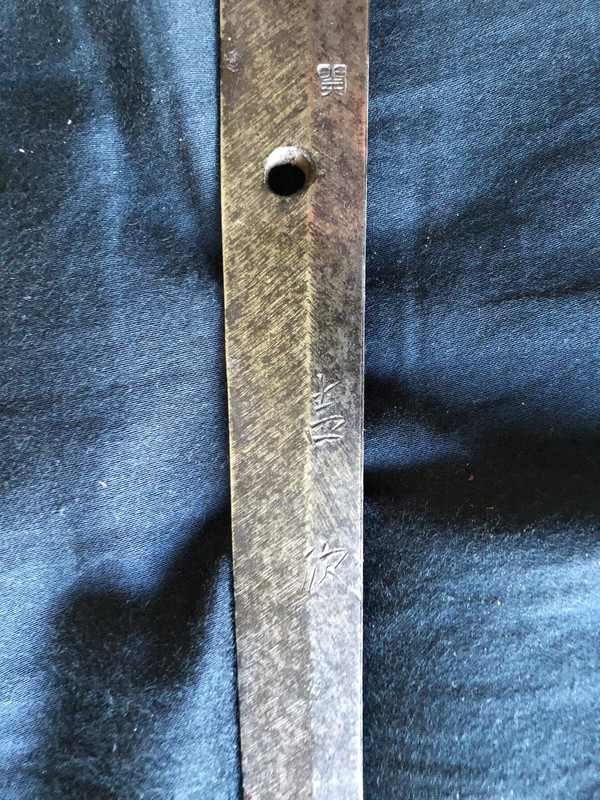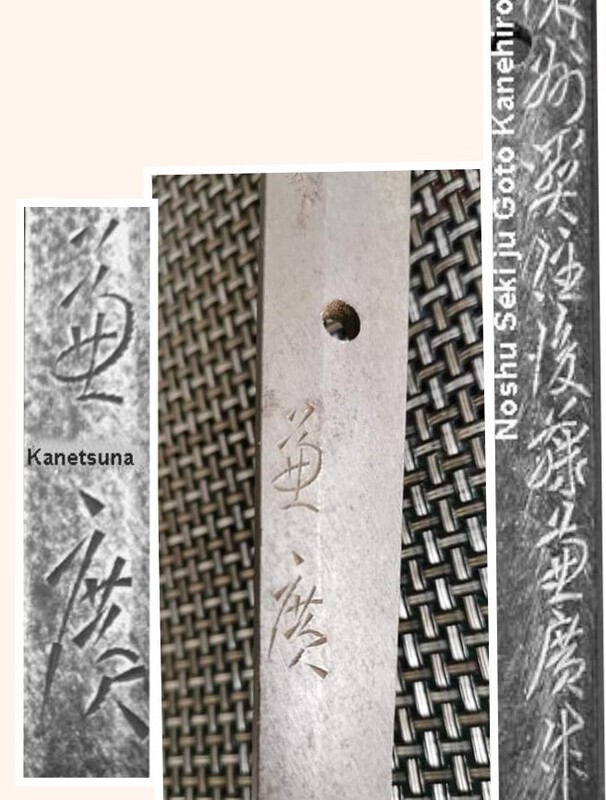-
Posts
11,071 -
Joined
-
Last visited
-
Days Won
128
Content Type
Profiles
Forums
Events
Store
Downloads
Gallery
Posts posted by Bruce Pennington
-
-
THIS ONE is either snake of shark. I think it's shark, though:

-
-
Enjoying the discussion, keep the examples coming!
-
I have never taken note of that. Ohmura's examples all 3 have centered chuso, like you say.
The guy to say would be @PNSSHOGUN of course!
-
 2
2
-
-
Both Army and Navy used ray skin. The Navy simply lacquered theirs black. I personally have never seen a 97 with shark same’.
I’ve seen a couple of 98s with unusual things like snake skin, though.
-
That's going to depend on your collecting goals. Mine was to find a good representative of all the official types of the WWII gunto. So a missing haikan (ashi) for me would be undesirable. I have bought gunto with missing seppa, but they are easily replaceable. My dad's Mantetsu was missing several parts and it took me 2 years to replace all the parts.
-
It’s not common. I think they just get loose and get lost. I have one that they are both very loose.
You may also be seeing the post war souvenir that comes with one hanger. Discussed here:
-
"Worth" is a nebulous term. The honest adds of Chinese "handmade reproductions" usually are asking $150 USD. Value just depends on who's buying for what reason. The charlatans make a killing by getting unsuspecting rookies to pay full market price for a fake worth $150.
-
Jason,
this one seems to be a replica/fake. the dimples where the rayskin should be are missing; really far-out Tokyo inspector stamp and the stacked-cannonballs are made with overlapping race-track shaped stamp. Best Suya imitation I've seen, though. Bohi at the tip is wrong for a Suay/Kokura blade. From a distance, it's pretty well made for a fake. Maybe one of those Polish replicas?
-
40 minutes ago, Mark S. said:
it doesn’t appear to have a serial number and I believe the pointed end of the bohi near the habaki is usual a tip off of fake? True?
You are right about the bohi, it's not right, and missing serial number is a red flag (though, some rare ones exist). The sori looks to large too.
-
36043 on both.
-
 1
1
-
-
Cant get the link to work. Can you post a picture?
-
Hmmm. Memorial for WWII? To what market? I thought most Japanese either didn't care (the young) or didn't want reminders (the old). Made for foreign buyers?
-
Could be that "dark gold" Fuller tried to describe.
-
That explains the angled cut in the top of that one seppa!
-
Rafaelle,
First - Thanks for sharing that sword!!! Wow, how cool to have custom koiguchi!
This is an important discussion at the moment (to me). For a LONG TIME it has been told, like an oral history, that there was a law established in the mid/late 1930's to required stamping of non-traditionally made blades. Currently, no such law has been found. Rather, what is known, and published, is from the Seki City website (thanks to Nick Komiya at Warrelics). It talks of the sword history of the city and says that in the 1930s, due to the Shanghai incident, and ramping up of military actions in China, the sword industry had to drastically increase their sword production. In the process of innovation, the industry started making sword industrially, non-traditionally. But local producers began to be bothered by low-quality "showato." They got the Seki Cutlery Manufacturers Association to inspect blades and stamp them to show that the blades (showato) passed quality inspections. This stamping began as early as 1935 and ran until the Army took national control of sword production in late 1941- early 1942.
Half of all surveyed blades are not stamped (Seki swordsmiths produced 70% of all war blades. Let that math fry your brain!). Surveyed, and dated, blades with stamps, show the Showa stamp as the earliest known stamp (1935). Observed Seki-stamped blades begin in 1940, but over half of the Seki-stamped blades are not dated. So it is POSSIBLE that it ran concurrently with the Showa stamp. But we don't know.
This is taking a long time to say that we believe the Seki stamp (and Showa) were being used by the Seki Cutlery Manufacturers Assoc. to stamp SHOWATO of good quality. In my survey, the Seki stamped blades almost always appear to be nihonto/gendaito. My personal opinion is that there were a mix that were either: 1. made in the traditional manner, yet used non-tamahagane, 2. made in the traditional way, but oil quenched; or 3. made non-traditionally in several ways, but were really good quality.
The bottom line is that we just don't have documentation to prove anything yet.
I discuss this all little more in depth in the Stamps of the Japanese Sword.
-
 3
3
-
-
Here is a great reference page for the names of your gunto parts: http://japaneseswordindex.com/glossary.htm
as is this one: http://ohmura-study.net/903.html
You can try posting in the Wanted to Buy NMB thread for your missing parts. I have some extra seppa. If you want to PM me with your mailing address, I'll send them to you. You can try them and find whatever fits and mail the rest back to me. But like Chris said, if the tsuka fits tightly, you don't need these.
I don't have the black one in this picture, but I have the others. If you find something you like, you'll have a shot-in-the-dark as to whether they fit on the nakago. If the hole is too small, it's OK to file the hole bigger. The fittings shops did the same thing. If too big, it might not work as the seppa could slide up or down and be visually out of place.
-
 1
1
-
-
Shamsy or Stegel would be the ones to say for sure, but I'm not bothered by those. Although the picture doesn't show the Iijima stamp clearly enough to tell.
-
 1
1
-
-
I wanted to say that, but I'm wrong most of the time, so I left it for the pro's.
-
Thanks guys! Kanehiro then.
Gwyn, thanks for the good example of Kanetsuna!
-
-
Would like your thoughts on this. Got a nakago for my files. I tried to find the name on Japaneseswordindex.com and came up with an exact match that said "Kanetsuna". But I cannot find a WWII Kanetsuna on the swordsmith index of the Nihonto Club Site. The name given by Chris Bowen is "Kanehiro." I wouldn't doubt Chris, so is there a correction needed on the oshigata page of @Rich Stein's site?
I am puzzled by the difference in strokes at the upper left corner of the second kanji in the tsuna vs hiro if they are the same name.
-
Well, I'm way out of my league in a tassel discussion, especially the pre-WWII kind. This is just from Fuller. Now, as good as his is, there are still things we've found out that have corrected his work on certain items. But, you can see from his page that the "dark gold" was found on that police sword.
-




.thumb.jpg.a8913f84ebd01230e66e1be3dabe58e2.jpg)





a gunto tsuba oddity
in Military Swords of Japan
Posted
THIS ONE is unknown, but could be snake: